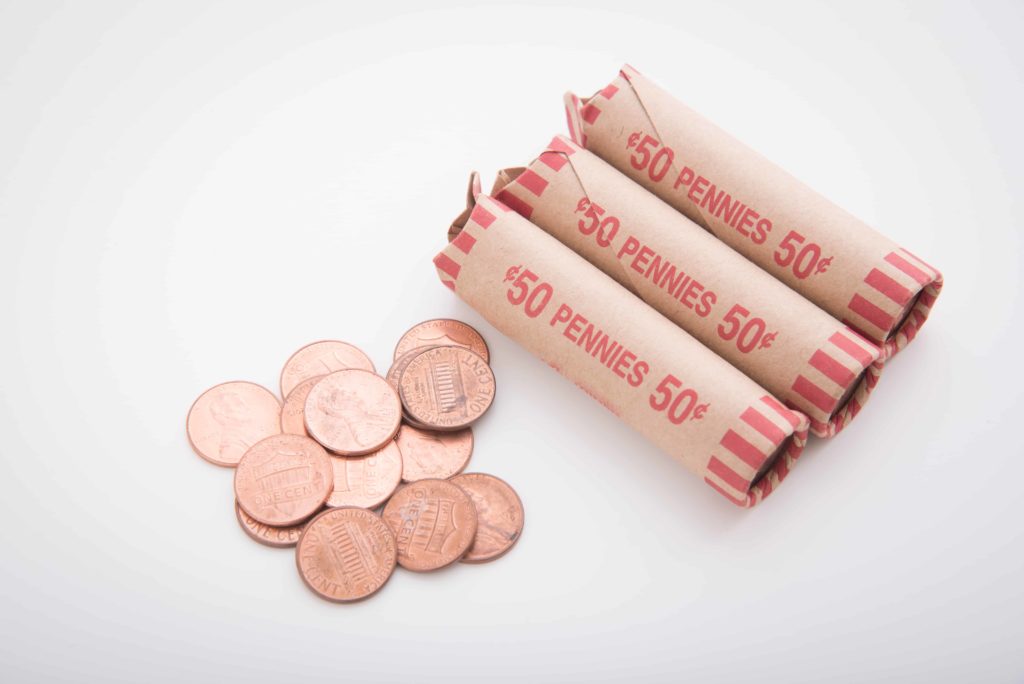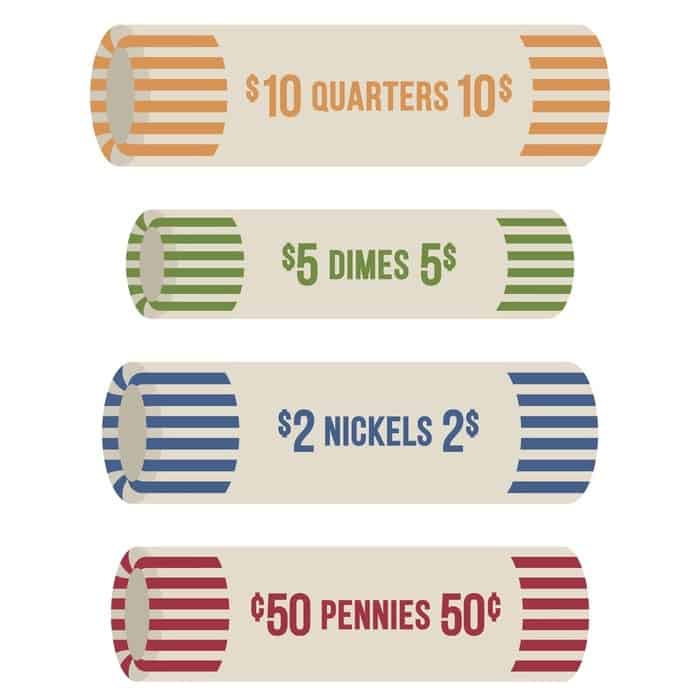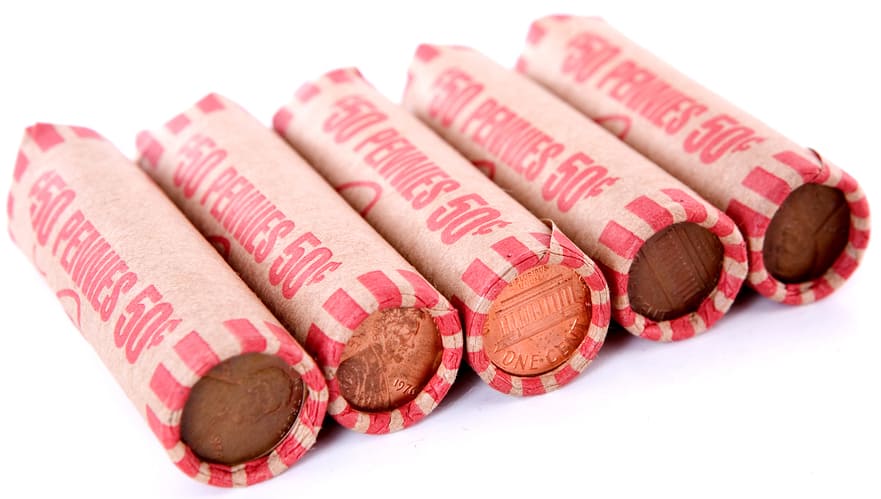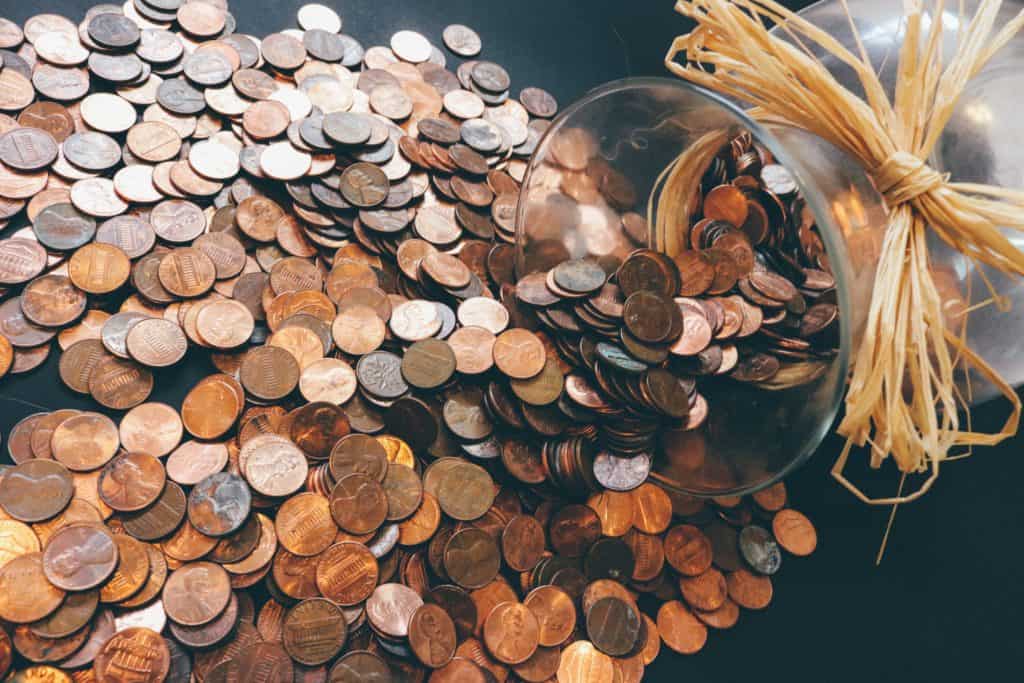How many coins are in a roll?
- Penny Rolls: 50 pennies = 50 cents
- Nickel Rolls: 40 nickels = $2.00
- Dime Rolls: 50 dimes = $5.00
- Quarter Rolls: 40 quarters = $10.00
- Half Dollar Rolls: 20 half dollars = $10.00
- Large/Silver Dollar Rolls: 20 large silver dollars = $20.00
- Small Dollar Coin Rolls: 25 small dollar coins = $25.00
How Many Pennies in a Roll?
“How many pennies are in a roll?” my son asks. “Fifty,” I answer. “One, two, three, four,” he begins to count. “Six, seven, eight, nine, ten!” He declares with utter excitement.
“Very good, keep going,” I respond.
Minutes later stacks of pennies stand before him. His little fingers grasp the piles and move them into perfect little rows. “Done!” he declares after counting and stacking all of the pennies. “How many nickels in a roll?”
“40,” I answer.
“5, 10, 15, 20…” he counts as he stacks the nickels on top of one another. When all the nickels have been counted he looks up and asks, “How many quarters in a roll?”
“40, but what about the dimes?”
“Oh yeah,” he says and the counting begins again. “10, 20, 30, 40, 50… wait how many dimes in a roll?” “Fifty,” I answer and he continues right where he left off. “60, 70, 80…”
Watching my son transports me back to my own childhood. Counting coins is a family tradition. I suppose the roots of my own passion for personal finance began when I was just four years old.
My First True Money Memory

I heard the familiar sound long before I saw it. The distinct sound of coins rattling inside a metal container. My dad kept his spare change in an old blue and orange cheese curls canister in the bottom of his closet.
Every so often he’d carry it into the kitchen where he would count and roll his coins. As he walked the coins shuffled and clinked in front of him.
As soon as I heard the noise I raced to the table, yanked out a chair and plopped myself on top of it. I didn’t want to miss a moment of the coin counting process.
“How much do we have?” I asked.
“We’ll have to count,” he responded, but I always tried to guess the amount before he dumped them out. I wanted to hold the container and feel how heavy it was. Of course, the weight and number of coins never provided a clue. A canister full of pennies provides much less value than a mound of quarters and half dollars. It turns out weight wasn’t a good indicator for guessing.
My dad unfolded newspaper, spread it out over the table and poured the quarters, dimes, pennies and nickels out onto the black and white words below. The moment the coins emerged the unmistakable smell of money filled the room.
As the coins tumbled out of the container I’d mentally separate the copper colored ones from those with silver tones. I estimated the total every time, but never came close to guessing the right number.
Coin Rolls
“You don’t need to stack them,” my dad always said, but I liked to see those little mounds of coins rising from the flat surface of the table. “How many pennies in a roll?” I asked just like my son did.
“Fifty,” my dad said, so matter of factly.

How Many Coins In a Roll?
I memorized the rolls and their associated values early on:
- Penny Rolls – 50 pennies ($0.50)
- Nickel Rolls – 40 nickels ($2.00)
- Dime Rolls – 50 dimes ($5.00)
- Quarter Rolls – 40 quarters ($10.00)
I memorized the colors too:
- Penny rolls – Red
- Nickel rolls – Blue
- Dime rolls – Green
- Quarter rolls – Orange
I quickly learned that 1000 pennies equals $10.00, which was the same as a roll of quarters. It was much faster to count quarters than pennies. I loved counting, “25, 50, 75, one dollar”, and hoping I had enough quarters for a $10 roll.
Rolling Coins With My Dad
The house seemed so quiet as we counted those coins. My dad sat on one side of the table and I sat directly across from him. After counting out fifty pennies I’d push my tiny tower towards the center of the table.
My dad never let me roll his coins. After I pushed the pile he took over the task of placing them inside the paper rolls.
We always sorted the coins in the same order. Pennies first, then nickels, dimes and quarters. My excitement grew as the numbers increased. Counting pennies seemed to take forever, but by the time we counted quarters the total always seemed HUGE!
As my dad rolled the coins he placed each roll in a neat and tidy row between us. The beginning and end of each matched up perfectly.
Rolling My Own Coins

At some point I received my own piggy bank and started counting and rolling my own coins. I distinctly remember the first time I tried to roll a pile of pennies. It felt incredibly strange to balance the very first penny that starts a roll.
There is a bit of an art to rolling coins. First, you place one finger in the bottom of the roll. Then you drop a penny inside from the top and keep it balanced horizontally as you drop more coins on top of it. As you stack them one by one the stack becomes heavy, solid and sturdy.
Counting my dad’s coins was fun, but counting my own was downright thrilling. Nothing felt better than completing a roll of quarters. Tucking in the ends of the roll and securing ten whole dollars felt like a major accomplishment.
I never spent any of the money I rolled. Instead I tucked the paper covered coins under my dresser where my brother couldn’t find them. My brother was notorious for spending all of his money and then asking to borrow mine.
Spare Change
If I was a few cents short of finishing a roll I would saunter sweetly into the living room in search of my mom. “Mom, do you have any spare change?” I would ask in the sweetest voice imaginable.
My mom was always willingly to give away her coins. She’d hand over her purse and tell me to dig to the bottom for loose change. My dad was never as generous. Sure he might hand over one or two, but if I needed more than that I’d have to wait until I found or earned them.
Eventually I started asking my mom for change on a routine basis. Every time I asked she pointed in the direction of her purse and told me to dig out whatever I could find. My brother swears I became wealthy from those early nickels and dimes. In some ways he isn’t wrong.
Counting Lessons
When my oldest son turned two I passed on the coin counting tradition. I didn’t know it at the time, but money is an incredible way to encourage numerical fluency.
Holding tangible coins in his little hands helped him keep track of the numbers as he counted. When he skipped a number or lost track of his counting he could drop everything back on the pile and start again.
I didn’t set out to create a math lesson, but by adding up all of those coins he learned to count quite quickly. We started with pennies, (counting by ones), and quickly moved on to nickels, dimes and quarters. In no time he was counting by fives, tens and even by twenty-fives.
Where Can You Find Coins?
Both of my boys love counting coins, but their passion for money ignited the moment we began searching for loose change. We now look for coins wherever we go out.
We find them on the ground, in Coinstar machines and in the coin returns of vending machines and arcade games.
When we go to the supermarket, drugstore, or a big box store my son walks slowly down each aisle looking for spare change. If you see a cash register you are likely to find coins. The ground around Walmart and Home Depot check out lines are particularly plush with spare change.
Other common places include candy machines in the center of malls or around children’s rides that cost fifty or seventy-five cents to ride. Customers often forget to pick up coins, so the coin returns at self-checkout machines are a great place to look too.
Do Dirty Coins Gross You Out?
Do dirty coins gross you out? I know a lot of people won’t touch coins on the ground, but it’s nothing a little soap and hand sanitizer can’t clean.
On most outings my boys find at least a coin or two. When they find a penny they even sing the penny song. These days they return home, divide their findings among the piggy banks and begin counting. Then they go wash their hands.
Money Lessons
Around the age of two or three my boys and I began playing a grocery store game. My kids are now four and eight, but they both still enjoy this one.
To begin we pull a bag of pretend food off the shelf and place the contents all over the couches and chairs in the living room. We group the food groups together like a real grocery store, but you don’t need to be so fancy. In fact, if you don’t need a supply of fake plastic apples and oranges. You could simply draw pictures of a few basic food products.
After we take everything out we place a small hand printed price beside each item. Then we create a shopping list of items we need. My children act as the cashiers and I pretend to be their favorite customer.
I come into the store with my list and they ring up the items I want to buy. In the beginning I provide them with exact change and ask them to count it. As they get older I give them extra money and ask them to give me the change.
We also create paper coupons. A coupon for $0.25 off paper products or $0.50 off a bottle of ketchup. Over the years they’ve learned to subtract the coupon from the total I owe.
This simple game has helped my children learn the basics of business and finance from right inside our living room. From an early age my children began to understand that we use money to pay for the things we want and need.
Numeric Fluency
It may be hard to conceptualize numbers, but playing with money helped my children understand that four quarters, ten dimes, twenty nickels and one hundred pennies all equal the same value.
By the same notion they came to understand that $10 can come in the form of one $10 bill, two $5 bills or ten $1 dollar bills. Money lends itself nicely to these types of computations.
I didn’t set out to teach my children math, but this simple grocery store game has provided them with profound numeric fluency and powerful computing skills. Over time they’ve naturally learned to compose and decompose numbers.
How many pennies does it take to make fifty cents? Fifty. How many nickels? Ten. List the number of ways we can break down thirty cents. How many different sets of coins can we use to provide the same value?
Sometimes we pay without using a particular coin. For example, pay fifty-five cents without using any quarters or pay $1.10 without using any dimes.
Using Coins to Introduce Financial Concepts to Children

In this modern age children rarely see their parents using real money to pay their bills. Instead they see their parents walk into a grocery store, swipe a plastic card and walk away with a bag full of food. It looks like magic to those young, watchful eyes.
Counting coins returns us to a time when cash changed hands. A time when employees cashed their paychecks on a Friday evening and went shopping with a wad of dough on Saturday morning.
With the invention of direct deposit, online banking and credit cards financial transactions now remain hidden from them.
Perhaps that shouldn’t sadden me but it does.
Counting coins at an early age helped me understand the value of money. Some say physical money may disappear from our world, but I sure hope not. I want to see the next generation of children searching for coins, asking “how many pennies are in a roll,” and counting them.
When we count coins together we can talk about how we wish to spend our money, save it or give it away to those in need. We can ask questions like, “What plans should we make for the money we find and earn?”
These early discussions can lead to larger financial discussions. They are the springboard for discussing the infinite possibilities that come from earning and saving. They also provide an incredible framework for talking about our values, hopes and dreams.
I wanted to do coin rolling with JB years ago! But for safety reasons we couldn’t. I’ve never met a child more willing to see if they would choke on something for so long before this kid… They didn’t stop sneaking stuff into their mouth for a taste until uh…last year? And just last week they stuck a glow stick in their mouth and crunched on it. ♀️ But we finally did our first coin rolling this year and JB loved it! Our technique is a little different since I couldn’t manage it one coin at a time early on. I make stacks, cradle the stack in my hand, then gently wiggle/slide the paper over it. I’ll need to do this more.
My first memories of money are fragmented, knowing we didn’t have much, knowing we couldn’t afford most things I wanted, being so desperate for books of my own that I snuck a quarter out of the coin dish at home to buy a book from a classmate in first or second grade. My teacher ratted me out My strongest memory was learning to write checks to pay the bills and being frustrated that we didn’t have any money to pay on time, and having to post date the checks. I was about 9 and that deeply bothered me.
My youngest loved to stick things into his mouth when he was very young, all of the balls in the ball popper were smashed as he shoved them between his lips, but after awhile he outgrew it. Oddly enough I don’t remember my oldest sticking anything in his mouth as a little one. So I guess I lucked out in that department. Clearly you can’t let them count money if they are going to try to eat it 🙂
I can’t believe your teacher ratted you out for that. I feel like a good teacher would have helped you get access to more books. I’m still trying to get those $1 books into the hands of kids who want to read them!
Post dating checks is an awful feeling. I remember my next door neighbor’s mom doing that and always shaking her head while she looked at the calendar to figure out what to write. I’m sorry you had to experience that as a nine year old.
I make up games to explain money to my kids too. Once, my youngest commented that I should “just write a check” when I told him something was too expensive. I thought for a minute and pulled out a glass bowl. Oldest kid got to be the bank (holding the bowl) the I got was the store owner and youngest was the customer. Gave youngest child Monopoly money and he made a deposit then wrote checks. I took the check to the banker and exchanged it for the cash he’d deposited.
I loved watching the light come on when he got it. Then we talked about what happens when you write a check and there isn’t enough money in the account.
That was years ago, but we’re still talking about money- I was explaining 401ks to oldest son on the way to school this morning…
I love making up children’s games with my kids too. If we don’t explain how things work then our kids will create their own stories about how the world works. When it comes to money I try really hard to talk to them about the reality of personal finance. It’s easy to see how they would get confused when everything happens as bits on a computer somewhere and very little money actually changes hands. Thanks for sharing your story. We haven’t talked too much about checks, so I might have to write a check the next time we play the grocery game!
My dad used to come home from a day’s work with a large jar / suitcase of spare change (which makes no sense as he was a flooring contractor) and dump it on the dining room table. His rule was “if you can count it, you can keep it.” I got very good at counting money quickly!
Our daughter’s in first grade and I bought her some workbooks for counting money, which I recently donated after realizing she’s like me – she wants to count cold, hard cash instead of seeing pictures of coins in a book.
That’s a sweet story about your dad. My children were never interested in workbooks about money either. They would look at a problem or two and then skip ahead to something more interesting, but put a few coins in their hands and they can solve all sorts of complex mathematical problems with them. I can understand that. Especially if they get to keep some of it after they are finished counting it!
My dad also had a spare change container for spare change! We’d roll them together and I’d get to keep all the pennies and nickels, while he’d keep the dimes and quarters. At a time when a $5/wk allowance was a lot, it was like getting a few weeks allowance at once.
It probably helped with math, money and a lot more than I didn’t even think about at the time!
I might just adopt this idea with my own children. I never thought about dividing up the coins by type. My dad was always stingy with his coins. He’s a generous man in many ways, but he was not going to hand over any of that change 😉 I love the idea of sharing the bounty with my kids. Let them count it, roll it and then keep it! Thanks for the comment.
Does anyone have books or videos to assist in explaining finance to my 8th and 10th grade sons? Their father is terrible with money and I’m not confident enough to teach them about loans, grants, scholarships, aprs, investments, IRAs, pensions, etc. myself. They know the basics of course but their schools don’t offer more than that. Thanks!
I’ve been searching for financial courses for my children as well. To be honest I haven’t found many good ones. I’ve even considered creating my own version to help kids learn. If I stumble across any in the future I’ll be sure to send you a note.
I have been an elementary teacher for 30 years. I am just so impressed that you followed your Dad’s tradition to you. Then, you followed up by passing it to your own sons. WOW!
Further more, you are willing to teach your own children skills at home, too. The schools just can’t do it all. We need parental support. It was so important to me that my students learn cursive writing! Now, laws are have been passed to not teach it in 48 states. Computers don’t always work. . .
I just had an 83 year old Aunt stay with me. She delights in finding “pennies from Heaven.” Good luck!
Thank you for sharing your story. My dad taught me a lot of things about money and I love passing them on to my kids. They gobble up these tidbits and I hope that a few of them will stick!